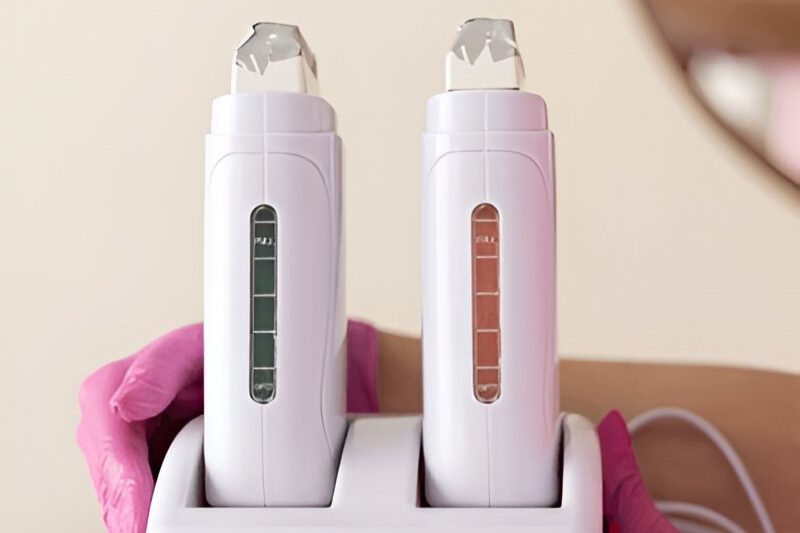At-home microneedling devices carry risks like infection, improper penetration, and barrier damage. Professional treatments offer sterile precision and better outcomes under medical supervision. However, there are several big reasons to avoid at-home microneedling.
What is microneedling?
Microneedling has become a popular skincare treatment. Not only can it improve skin texture. But also reduces the appearance of scars and promotes collagen production. Furthermore, the procedure involves using fine needles to create tiny punctures in the top layer of the skin. While professional microneedling is performed in a controlled environment. On the other hand, many individuals may be tempted to try at-home microneedling devices.
Avoid At-Home Microneedling – Key Risks
1. Risk of Infection
Without a doubt, one of the biggest risks associated with at-home microneedling is the potential for infection. Although professional environments use sterile equipment. Then, follow strict hygiene protocols to minimize this risk. Whereas at home, microneedling devices can be challenging to achieve the same level of sterility. As a result, the improper handling or cleaning of the needles can lead to bacterial infections.
3. Depth of Needle Penetration
Similarly, professional devices allow for precise control over the depth of needle penetration. Particularly crucial for treating different types of skin issues and different areas of the face. To point out, at-home devices typically have a fixed depth. In fact, they may not be appropriate for all areas or skin types. This leads to less effective results or an increased risk of injury.
2. Potential for Allergic Reactions or Adverse Effects
To demonstrate, professionals can foresee potential reactions based on your skin’s history and current condition. But at home microneedling devices, you might not be aware of certain risks. Finally, it can lead to allergic reactions, hyperpigmentation, or other skin irritations.
Avoid At-Home Microneedling – Key Complications
1. Ineffective Results
Microneedling devices for home use claim to deliver results, but their needles tend to be shorter and less capable of stimulating collagen production effectively. In truth, microneedling at home offers slight enhancements to skin appearance. However, professional microneedling employs longer needles & advanced methods. Eventually resulting in more noticeable and enduring improvements.
2. Potential for Scarring
To illustrate, inexperienced users may unintentionally cause injury to their skin during at-home microneedling. Subsequently, overuse of the device or applying excessive pressure. It can further lead to micro-tears in the skin, resulting in scarring or hyperpigmentation. In contrast, professionals are trained to handle potential complications and can adjust their techniques to minimize any risks.
3. Delayed or Inappropriate Response to Complications
To emphasize, if complications arise during professional treatment. Then, immediate and appropriate responses can be administered. To put it differently, at home, there might be a delay in recognizing complications. As a matter of fact, a lack of knowledge about how to deal with them. Consequently, it can exacerbate the situation.

Avoid At-Home Microneedling – Key Concerns
1. Improper Technique
Microneedling requires specific techniques to be effective and safe. Professionals are trained in these techniques and understand how to apply the right amount of pressure, how to treat different areas of the face, and how to adjust the treatment based on the skin type and condition. Incorrect technique at home can lead to uneven results, excessive skin damage, and scarring.
2. Lack of Customization
In reality, each individual has their own skin type with varying requirements and issues. Henceforth, the professionals assess each client’s skin type and conditions to tailor treatments accordingly. At-home devices usually come with generic instructions that may not consider your specific skin type or issues. Without professional guidance, you may not see your desired results.
3. Lack of Expertise
Dermatologists and skincare professionals can assess your skin type, identify specific issues, and recommend a tailored treatment plan. They can monitor the progress and make adjustments as needed. At home, without this expertise, you might not choose the best treatment, potentially leading to ineffective results or worsening of skin problems.
Avoid At-Home Microneedling – Key Considerations
1. Quality of Tools
Professional microneedling tools are typically of higher quality and more sophisticated than those available for home use. At-home devices may not be as effective and could potentially cause harm if they are poorly manufactured or become dull.
2. False Economy
While at-home kits may seem less expensive initially, the potential costs due to complications, ineffective results, or the need for professional treatment to correct poor results can ultimately make it more costly.
Avoid At-Home Microneedling – Popular FAQs
What is microneedling?
Microneedling uses small needles to make tiny holes in your skin. This process helps your body make new collagen, which makes your skin look better. The treatment is simple but effective. A special tool with many small needles rolls across your face to create these tiny holes. Your skin then starts to heal itself. As it heals, it makes fresh collagen and new skin cells. This leads to smoother and younger-looking skin. Most people need several sessions to see the best results. The process is safe when done by a trained expert.
How does microneedling improve the skin?
Tiny needles can help make your skin look better. The treatment creates small holes in your skin that help it heal & look fresh. It works well to reduce scars and make wrinkles less noticeable. Many people choose this method because it makes their skin smoother and younger-looking. The process is safe and helps your face produce new healthy skin cells.
Does microneedling work for stretch marks?
Microneedling uses tiny needles to make small holes in the skin. These holes trigger the body to make more collagen and heal itself. When your skin heals, it looks better, and stretch marks become less noticeable. The process works well because it helps create new skin cells and makes the skin surface smoother. Many people choose this method because it’s effective for reducing the look of stretch marks over time.
How long does a microneedling treatment take?
Typically, a microneedling session lasts between 30-60 minutes. The time depends on how big the treatment area is and how deep the needles need to go into your skin. The process is pretty straightforward, and your doctor will explain everything before starting.
How should I care for my skin after a microneedling treatment?
After microneedling, you need to take good care of your skin. Stay out of the sun and only use mild skin products. This helps your skin heal better and gives you the best results. Keep your skin clean and don’t put on makeup for the first day. Your skin needs time to recover, so be gentle with it.
Is microneedling safe?
When done by a trained professional, microneedling is considered safe, with minimal risks and side effects. However, it is important to follow pre- and post-treatment care guidelines to minimize any potential risks.
Is microneedling painful?
While some people may experience discomfort during microneedling, most find it to be tolerable with the use of a numbing cream.
How many sessions of microneedling are needed for results?
Typically, multiple sessions of microneedling are recommended for optimal results, with most people seeing improvement after 3-6 sessions.
Is there downtime after a microneedling treatment?
There is usually minimal downtime after microneedling, with some redness and mild swelling that typically subsides within a few days.
Can microneedling be done at home?
While at-home microneedling devices are available, it is recommended to seek professional treatment for the best and safest results.
Is microneedling suitable for all skin types?
Microneedling can be done on most skin types, but it is important to consult with a professional to determine if it is the right treatment for you.
Are there any side effects of microneedling?
Common side effects of microneedling include redness, swelling, and mild irritation, but these usually subside within a few days.
Can microneedling help with acne scars?
Indeed, dermatologists or aestheticians use microneedling to improve the appearance of acne scars. By stimulating collagen production and promoting skin regeneration.
How soon can results be seen after microneedling?
Results from microneedling can be seen within a few weeks to a few months, with continued improvement over time as collagen production is stimulated.
Can dermatologists combine microneedling with other treatments?
Yes, dermatologists can combine microneedling with other treatments. Such as PRP (platelet-rich plasma) or serums to enhance results and promote deeper skin rejuvenation.
Avoid At-Home Microneedling – Book Your Microneedling Treatment in Tampa, Florida
For these reasons, it is generally safer and more effective to opt for professional microneedling treatments. Rather than attempting this procedure at home. Regardless, at-home microneedling may seem like a convenient and cost-effective option. But the risks far outweigh the benefits. If you are considering microneedling, consult with a licensed surgeon, Dr. Stan Castor, who can provide advice tailored to your specific skin needs.
Call us at (813) 971-2000 to inquire more about the treatment, or use the online form to book your Skin Pen® Microneedling Treatment in Tampa, Florida. In addition, visit our extensive before-and-after treatment gallery.

